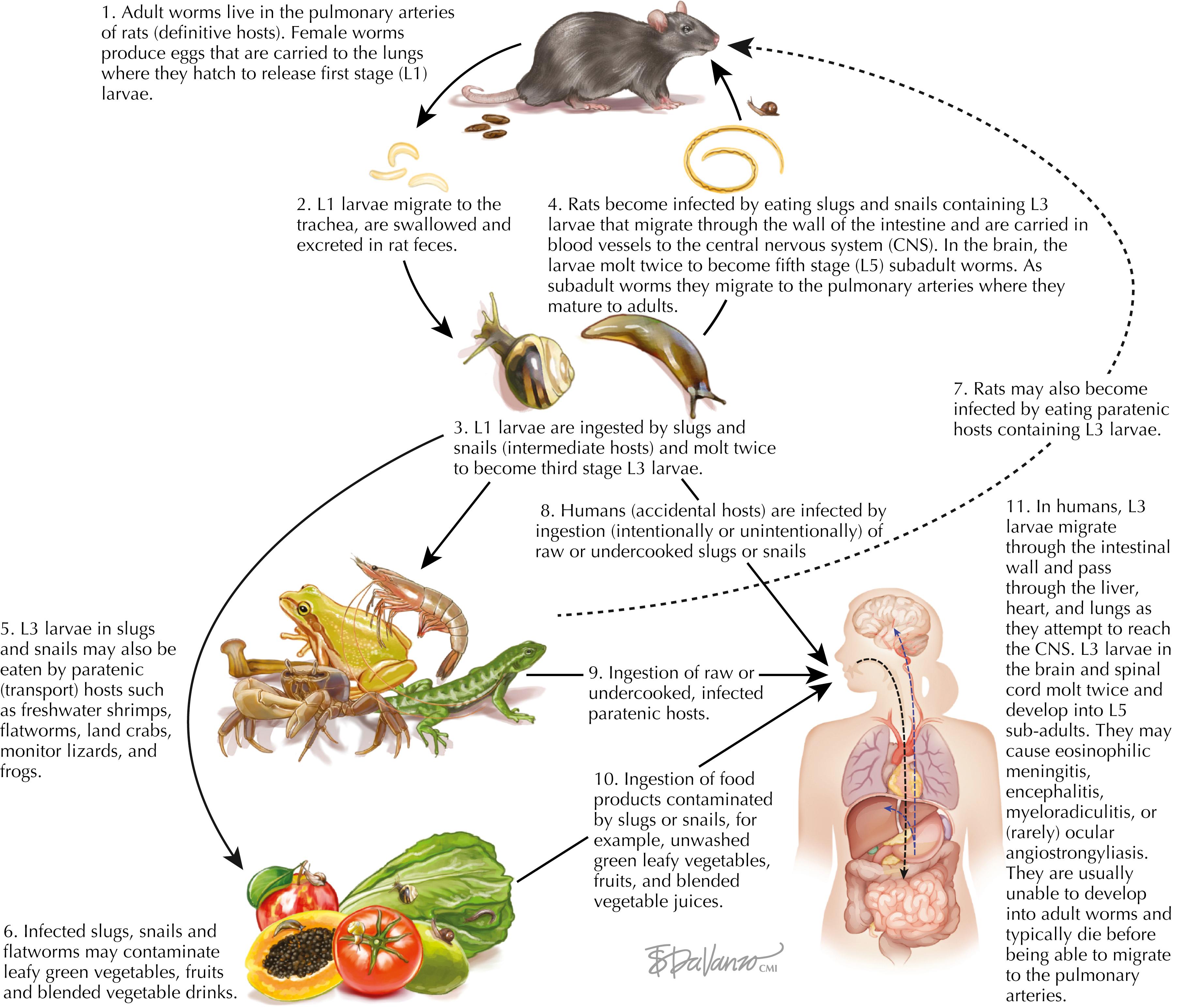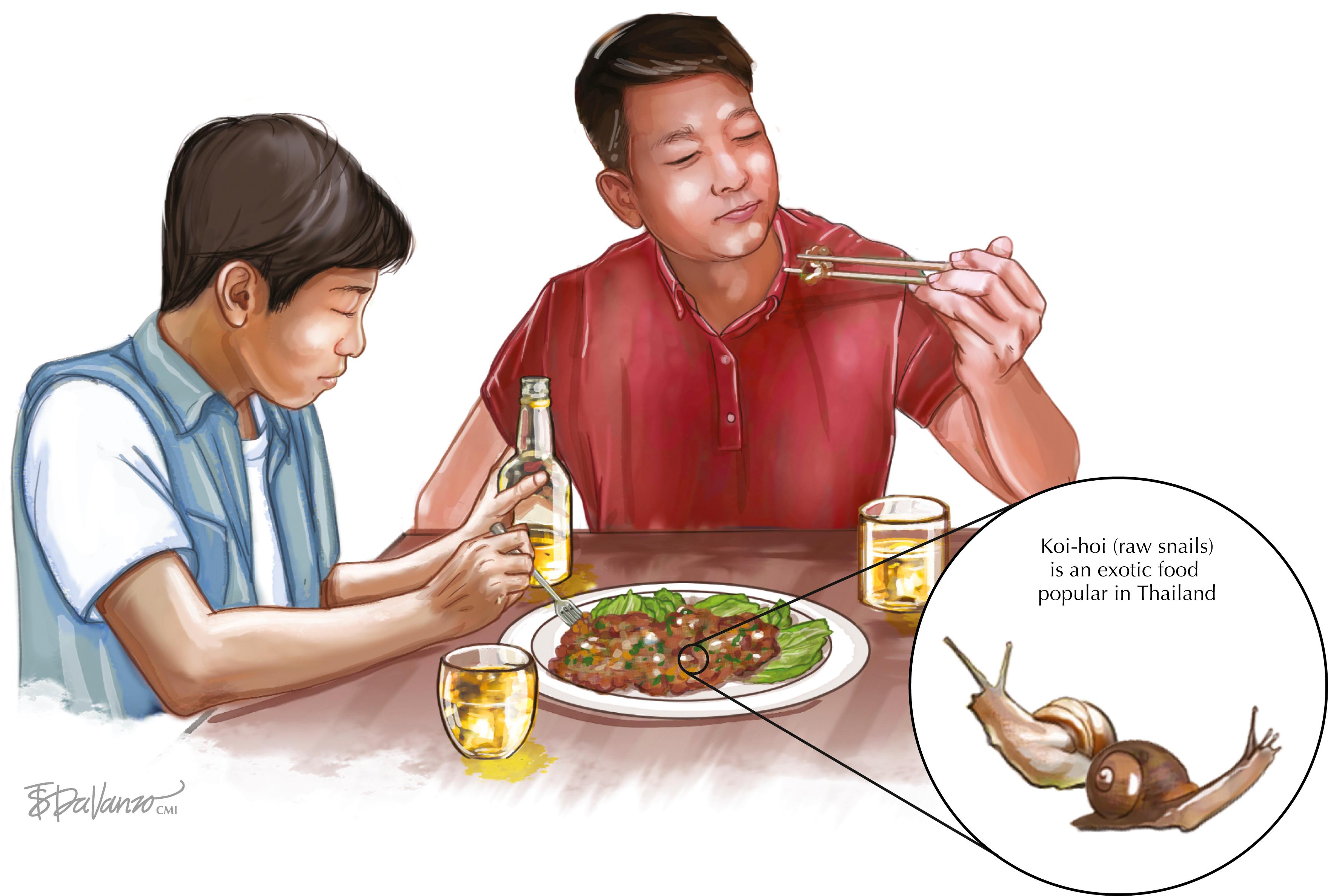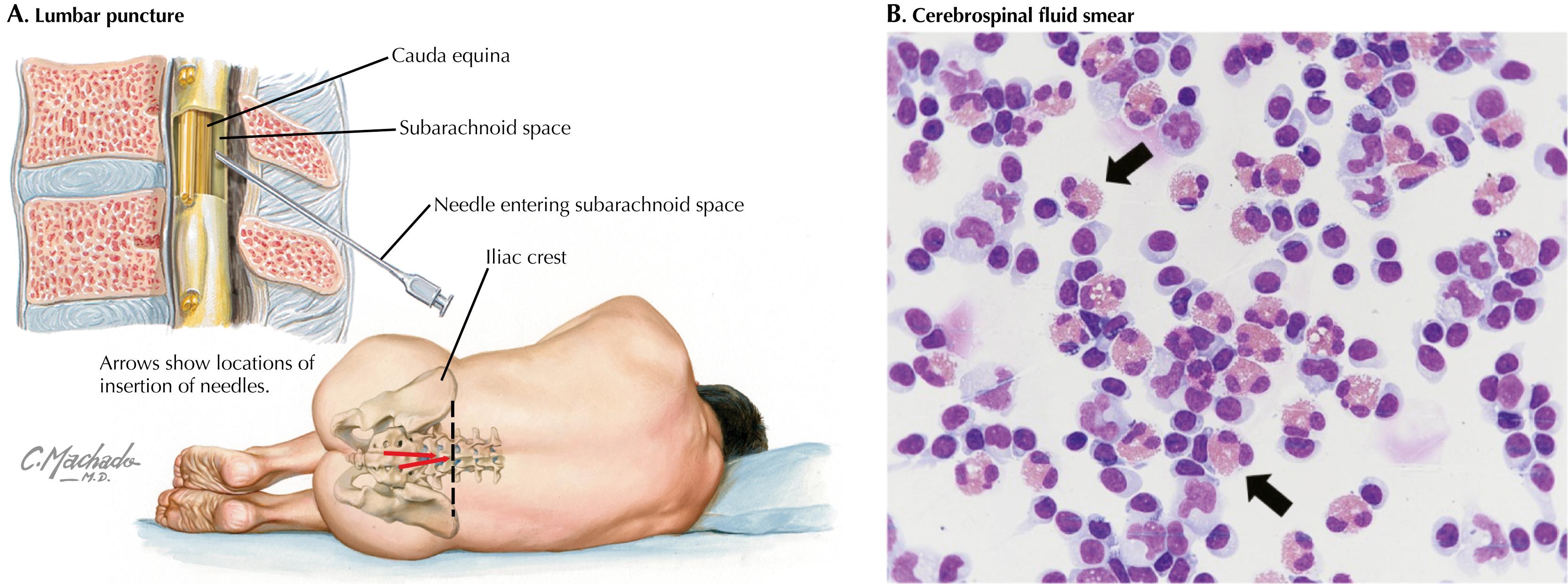Physical Address
304 North Cardinal St.
Dorchester Center, MA 02124
Neuroangiostrongyliasis (NAS), or rat lungworm disease (RLWD), is an important emerging infection spreading around the world. It is caused by Angiostrongylus cantonensis, a nematode parasite, and is the commonest parasitic cause of eosinophilic meningitis. Infection can also cause cranial nerve (CN) palsies, encephalitis, and radiculomyelitis. Another form of the disease, ocular angiostrongyliasis, is very rare but occurs when a larval worm invades the eye.
Initial symptoms are nonspecific, and an early diagnosis requires a very high index of suspicion. Somewhat later in the course of the illness there may be more specific symptoms, but even then they can be very unusual and confusing, and the diagnosis still requires a high index of suspicion. Many infections result in a benign illness with recovery within a few weeks following symptomatic and supportive care. It has become increasingly recognized, however, that some infections, particularly in certain parts of the world, may result in more severe illness with long-term neurologic deficits, significant disability, and death.
A presumptive diagnosis is made by finding evidence of an eosinophilic meningitis in a patient with a history of suggestive symptoms who is living in or has traveled to an endemic region. The diagnosis can be confirmed by finding larvae in the cerebrospinal fluid (CSF) or the eye, but this is rare. It can also be confirmed by real-time polymerase chain reaction (RT-PCR) testing for A. cantonensis DNA in the CSF. This important test became available recently but is currently available only in the United States and a few other countries. If PCR testing is available, antibody testing is not usually recommended for diagnosis in an acute illness. Except in very mild cases, treatment with high-dose corticosteroids is recommended for almost all cases. Treatment with anthelminthics has been controversial for decades because of theoretical concerns that it could provoke a severe inflammatory reaction in the brain or spinal cord. Increasing experience, however, suggests that early treatment (ideally within 2–3 weeks of infection) with anthelminthics such as albendazole combined with high-dose corticosteroids is safe and effective. It remains to be seen, however, if this approach will reduce the incidence of chronic neurologic sequelae, long-term disability, and death in more severe cases.
Prevention involves adequately cooking intermediate hosts such as slugs and snails or transport hosts such as freshwater shrimps, freshwater crabs, frogs, and monitor lizards. Green leafy vegetables and fruits should be thoroughly washed to remove any contaminating slugs, snails, or mucus.
A 42-year-old organic farmer presented with a 2-day history of generalized headache. It was unusually severe, unlike any previous headaches he had had, and there was no associated fever. Past medical history was unremarkable. He lived on Hawaii Island in Hawaii and had no history of recent foreign travel. Physical examination by his primary care physician (PCP) was unremarkable, and he was diagnosed with tension-type headache. Ibuprofen and baclofen were prescribed.
Two days later he presented at a nearby urgent care clinic. His headache was worse, and he had developed shooting “electric shock” pains in his left arm and numbness in his right leg.
Physical examination was again unremarkable. His complete blood count (CBC) showed white blood cells (WBCs) 7800/mL, neutrophils 67%, lymphocytes 31%, and eosinophils 2%. A diagnosis of tension-type headache with anxiety was made and alprazolam was added to his drug regimen. Over the next 3 days his headache persisted, and the left arm pains became worse. In addition, he developed numbness in the left leg, and a sensation of “a thousand paper cuts” on the skin of his right leg.
Frustrated by worsening symptoms and lack of a specific diagnosis, he went to a nearby emergency room (ER). He was afebrile. Mild neck stiffness was noted but examination was otherwise unremarkable. His CBC showed WBCs 11,210/mL with 6% eosinophils. Computed tomography (CT) of the head was normal. He was told that he probably had stress headaches with anxiety, urged to follow up with his PCP, and referred to an outpatient neurologist.
By the following day the electric shock pains had become intolerable and were now described as like “ice picks.” In addition, he had developed nausea, night sweats, and insomnia. He sought care in another ER. A friend had told him about RLWD, and he refused to leave the ER until he had had a lumbar puncture (LP). This was done and showed slightly turbid CSF. The opening pressure was 240 mm H 2 O (normal 60–200 mm H 2 O). The CSF WBC count was 240/mL with 27% eosinophils. CSF protein was 49 mg/dL (normal 28–38 mg/dL).
Further history revealed that the patient often ate food directly from his farm and did not routinely examine or wash green leafy vegetables before consuming them. There was no history of intentionally eating raw slugs, snails, shrimp, or other unusual uncooked foods. He recollected that about 7 days prior to the onset of his headache he had experienced a few days of malaise with transient upper abdominal pain, nausea, and diarrhea associated with a cough and sore throat. Following his LP, a diagnosis of eosinophilic meningitis was made, with a presumptive diagnosis of NAS. CSF was sent for RT-PCR testing for A. cantonensis DNA. He was admitted to hospital and promptly started on treatment with high-dose corticosteroids and albendazole. The diagnosis of NAS was confirmed 3 days later with a positive PCR result.
COMMENT: There was no clear exposure history, but this patient may have been infected after unintentionally swallowing a slug hidden in unwashed salad vegetables from his farm. Symptoms prior to the onset of his headache may have been caused by migrating parasites on their way to the brain and spinal cord. He had a confusing array of very unusual migratory symptoms that led to a delay in diagnosis, fragmented care, and his resulting frustration. There were certain “red flags” that were not immediately recognized. These included an unprecedented severe headache and significant eosinophilia on his first ER visit; these could have prompted a more focused workup at an earlier stage of his illness. A detailed food history would have revealed that he had eaten unwashed salad vegetables directly from his farm, a significant risk factor for NAS. In addition, questioning regarding a prodromal illness might have prompted a more focused workup and resulted in an earlier diagnosis.
NAS, or RLWD, is the result of infection by A. cantonensis , a nematode parasite. It is an important emerging disease that is spreading around the world. The natural life cycle of the parasite involves transmission between rats (definitive hosts), snails, and slugs (intermediate hosts). Humans are accidental hosts. Transport or paratenic hosts such as freshwater shrimps, flatworms, frogs, monitor lizards, land crabs, and centipedes may also be important in the life cycle ( Fig. 93.1 ).

Humans may become infected in a variety of ways. For example: (1) Eating raw or undercooked intermediate or transport hosts in exotic foods such as “koi-hoi” (snails) in Thailand or Laos ( Fig. 93.2 ) or eating raw shrimp dishes such as “taioro” in French Polynesia or “dancing” (live) shrimp in Thailand; (2) Swallowing raw snails or slugs as a wager or dare; (3) small children or the mentally challenged playing with and possibly swallowing slugs or snails; or (4) accidentally ingesting raw intermediate hosts such as small slugs or snails or paratenic hosts such as flatworms contaminating green leafy vegetables, fruits, or blended vegetable juices. The role of mucus containing infective larvae as a source of infection remains unclear.

A. cantonensis infection was first identified in rats in Canton (Guangzhou), China, in 1935 and the first case in humans was diagnosed in Taiwan in 1944 during World War II (WWII). In the chaotic conditions at the end of WWII and immediately afterwards there were large outbreaks of eosinophilic meningitis, subsequently recognized to have been caused by A. cantonensis infection in several Pacific islands.
Following WWII there was a significant increase in commercial shipping, with many of the ships carrying stowaway rats; this resulted in spread of the disease to other countries in the Pacific and South and Southeast Asia. Over the past 60 years the disease has spread beyond the traditional endemic areas to many of the Caribbean Islands, the southeastern United States, and countries such as Brazil and Ecuador in South America and African countries such as Egypt, Nigeria, Ivory Coast and South Africa. It has been identified in animals in the Canary Islands and Mallorca (Balearic Islands), suggesting that the disease may soon be seen in humans in areas such as southern Europe.
NAS is an important emerging disease. Over 2900 cases have been reported worldwide, but undoubtedly this is a significant underestimate, because many cases are unrecognized or underreported. It is very likely that well over 10,000 cases have occurred worldwide since the disease was first identified in humans in 1944. Large outbreaks have been reported from China since 1997. There is a particularly high incidence of disease in northern and northeastern Thailand, where many cases are the result of eating raw or undercooked snails in dishes such as “koi-hoi” or raw or undercooked shrimp in dishes such as “dancing (live) shrimp.” Typically both dishes are consumed with a variety of spices and local alcoholic drinks, none of which adequately prevent infection (see Fig. 93.2 ).
Increasing numbers of cases are being recognized in travelers from nonendemic areas to endemic areas. These cases are expected to increase as a result of factors such as worldwide spread of the disease, globalization of trade, climate change, increased travel to exotic areas, ignorance of the disease, and more adventurous eating habits in travelers ( Box 93.1 ).
Unusual, confusing, occasionally migratory neurologic symptoms and signs.
Allodynia with descriptions of pain such as “a thousand paper cuts,” “severe sunburn” (without sun exposure), “lightning or electric shock sensations.”
New, unusually severe headache with or without peripheral blood eosinophilia.
Meningitis and peripheral eosinophilia.
History of travel to an endemic area.
History of residence in an endemic area.
History of ingestion of raw or undercooked slugs or snails.
History of ingestion of raw or undercooked transport (paratenic) hosts (e.g., shrimps, land crabs, monitor lizards, flatworms, frogs, centipedes).
History of ingestion of unwashed green leafy vegetables or fruits grown in an endemic area.
History of an otherwise unexplained prodromal illness.
Following infection, the earliest symptoms are very nonspecific. They result from migrating, neurotropic, third-stage (L3) larvae as they travel from the small intestine through the liver, heart, and lungs to the brain and spinal cord. Symptoms during this prodromal phase may include abdominal pain, nausea, vomiting, anorexia, diarrhea, malaise, myalgias, low-grade fever, headache, cough, sore throat, and dyspnea. Larvae in the skin may produce a rash and pruritus. Larvae in the kidneys may cause microscopic hematuria. Unfortunately, as these are nonspecific signs and symptoms, it is very difficult to make a diagnosis of NAS during this phase of the illness.
Once the L3 larvae reach the central nervous system, more specific symptoms may appear. The most common manifestation of NAS is eosinophilic meningitis (EOM) or meningoencephalitis. In addition, there may be radiculomyelitis or CN involvement. Ocular angiostrongyliasis is very rare but occurs when a larva enters the eye.
The most common symptoms of EOM in adults are headache, neck stiffness, nausea, and vomiting. Headache is almost always present. It often comes on suddenly and can be severe. Significant fever is uncommon at this stage but may occur if there is severe encephalitis. Insomnia, night sweats, anorexia, and weight loss may also be present. If there is radiculomyelitis, there may be severe disabling nerve pain, patchy sensory loss, and dysesthesias sometimes described as “severe sunburn,” “ice picks,” “electric shocks,” and a “thousand paper cuts.” Crawling or burning sensations are also common. Photophobia, phonophobia, and heightened skin sensitivity (allodynia) may occur. Examples include the touch of clothing on the skin, which may be unbearable, or the breeze felt while driving with a car window rolled down. Muscle weakness and difficulty walking are common, and there may be bladder or bowel dysfunction. Focal neurologic findings that are migratory or often do not follow a dermatomal distribution are often present. Symptoms and signs may fluctuate and change over time, creating confusion and delaying the diagnosis.
Physical examination may reveal neck stiffness, papilledema, and impaired consciousness. CN involvement causes diplopia (CN VI), facial weakness (CN VII), tinnitus, and hearing loss (CN VIII). Deep tendon reflexes may be normal, increased, or decreased depending on the area involved in the brain or spinal cord.
Children tend to have less paresthesias but more fever, irritability, somnolence, lethargy, gastrointestinal symptoms (vomiting, anorexia, and abdominal pain), seizures, and limb weakness.
NAS often presents with nonspecific, unusual, or bizarre symptoms. As a result, clinicians must have a high index of suspicion to make the diagnosis early in the course of the illness (see Box 93.1 ) Whenever possible, the goal is to make a presumptive diagnosis and start treatment with high-dose corticosteroids and albendazole within 2 weeks of infection.
LP with measurement of the opening pressure and examination of CSF for eosinophils is an essential part of the evaluation of NAS. It is a low-risk procedure with additional therapeutic benefits including relief of headache ( Fig. 93.3 ).

EOM is the hallmark of the disease. Traditionally it is defined as the presence of 10 or more eosinophils per milliliter of CSF or eosinophils accounting for 10% or greater of CSF WBCs or when there are at least 6 total WBCs/mL in the CSF. It is very important to make sure that the laboratory is staining the CSF for eosinophils. NAS is the commonest parasitic cause of EOM, but several other diseases may be responsible ( Box 93.2 ). Eosinophil counts may be absent or low in the CSF in the early stages of disease. If the diagnosis of NAS remains a concern, then repeat examination within a few days may be indicated. If the diagnosis is strongly suspected, it may be reasonable to start treatment immediately with high-dose corticosteroids and albendazole.
Angiostrongylus cantonensis
Gnathostoma spinigerum
Baylisascaris procyonis
Toxocara cani
Cysticercosis (Taenia solium)
Paragonimus spp.
Schistosomiasis (Schistosoma japonicum)
Fascoliasis
Become a Clinical Tree membership for Full access and enjoy Unlimited articles
If you are a member. Log in here